VISIT OF THE UNITED STATES AMBASSADOR TO SIC ICWC
United States Ambassador Mr. Richard B. Norland visited on 14 May 2008 the Scientific-Information Center ICWC on the invitation of Director Prof. V.A. Dukhovny.
Director Prof. V.A. Dukhovny, Deputy Director V.I. Sokolov, Director of ICWC Training Center P.D. Umarov, key specialists of SIC A.G. Sorokin, B.K. Turdybayev and others took part in the meeting.
Ambassador Mr. Richard B. Norland was familiarized in detail with the activities of SIC ICWC in regard to the implementation of integrated water resources management in the region, development of information system on water and land resources management in the Aral Sea basin, studies in water and power sphere, and activities of the ICWC Training Center.
ABOUT CAREWIB PROJECT ACTIVITIES
The CAREWIB Project team organized and held on 29-30 April 2008 in Bishkek a training workshop on creation of a national information system in the Kyrgyz Republic.
The workshop participants were welcomed by Mr. B.T. Koshmatov, Director General of the Department for Water Resources at the Ministry of Agriculture, Water Resources and Processing Industry (DWR MAWRPI) of the Kyrgyz Republic, and Prof. V.A. Dukhovny, Director SIC ICWC.
It should be noted that the leadership of DWR MAWRPI KR understands the importance of the national information system (NIS) and actively provides support to its creation process. Persons responsible for collection and transmission of needed information to DWR were appointed in the Department for Water Resources as well as in each Basin Water Authority (BWA).
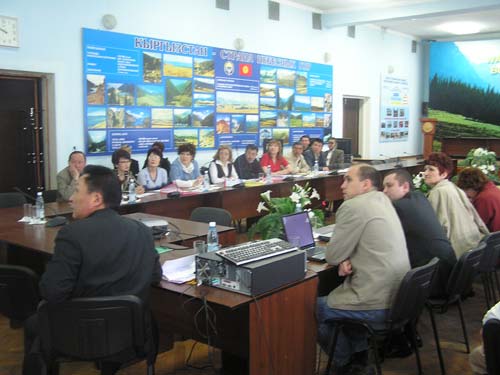
Project Manager I.F. Beglov familiarized the participants with the project goals and objectives and all the sections of the CAWater-Info portal.
Special teaching training materials of the project were prepared for training workshops:
- Guidelines for use of the CAWater-Info portal in daily practice;
- Guidelines for use of the Regional Information System of the Aral Sea basin countries, and
- Instructional guidelines for creation of a water information system at the national level.
IS Block Coordinator D.A. Sorokin presented the participants the regional information system CAREWIB, including its sections available at the portal. After that, D.A. Sorokin presented in detail a model of national information system prepared by CAREWIB Project specialists, including new sections of the database such as “Land reclamation section”, “Water use section”, “Dispatcher control service”.
CAREWIB project programmer A.V. Kats conducted practical training exercises with the training participants.
During the discussions on national information system, the workshop participants noted the following problems impeding the creation of NIS:
- the Osh BWA has no computer with a capacity required for NIS needs.
- The Chui and Talas BWAs have no capability for long-distance communication.
- All BWAs except the Talas have no direct email.
- the workshop participants ask the leadership of DWR to assist in solving these issues.
The CAREWIB Project team organized and held from 13 to 15 May 2008 in Astana a training workshop on creation of a national information system in the Republic of Kazakhstan.
The Administration of the Committee for Water Resources (CWR) at the Ministry of Agriculture (MA) of Kazakhstan gives special attention to the creation of a national information system (NIS) in the Republic of Kazakhstan. Toward this end, along with representatives from the Aral-Syrdarya Basin Water Authority (BWA), employees of the Nura-Sarysu and Ishim BWAs were invited to the training. The latter were selected as pilot ones for application of the national information system. In case of successful application of the created national information system, their experience would be transferred to other BWAs.
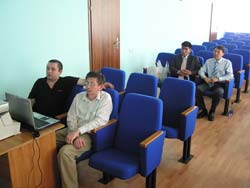
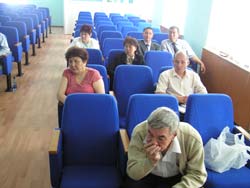
D.A. Sorokin and A.V. Kats conducted practical training exercises, during which the following were done:
- requirements for national information system on a number of parameters were specified;
- all the provinces in Kazakhstan were included in the NIS database;
- training on information system installation was conducted;
- practical skills on data input in NIS were given;
- complete NIS installation packages were provided to employees of the Nura-Sarysu and Ishim BWA.
During the discussions on national information system, the workshop participants noted the following problems faced in the creation of NIS, and expressed their wishes:
- for daily activities of CWR, aggregation of the created NIS with output information of the database “2TP-vodkhoz” and predictive analytical modeling instrument developed by SIC ICWC is of interest. Further activities of the national Focal Point will be developed in this direction,
- NIS should include input forms on water disposal, in which a capability for information input on water inlet types (water bodies, disposal fields and so on) should be provided,
- There are certain difficulties in input of some data, which should be received from outside organizations. For example, RSE “KazHydromet” is ready to provide data on a paid basis only.
Based on the workshop results, the following decision was made:
- The National Focal Point should focus the work on the creation of a national information system in the Republic of Kazakhstan in pilot Nura-Sarysu and Ishim BWAs;
- The progress in these activities should be assessed in October 2008,
- In case of positive assessment of activities, the application of experience in other basin water authorities of Kazakhstan should be started.
In conclusion, all the workshop participants expressed sincere gratitude to workshop organizer – SIC ICWC, administration of DWR MAWRPI Kyrgyz Republic and CWT MA Kazakhstan, and workshop sponsor – Swiss Agency for Development and Cooperation (SDC).
WATER REGISTERED
An automated control system of the Aravan-Akbura Canal was put into operation in Osh province.
CEOs of the province, representatives of the Swiss Agency for Development and Cooperation, officials of water management organizations in Kyrgyzstan, Tajikistan and Uzbekistan took part in the opening ceremony of the object at the canal headwork in Toloykon village, Kara-Su district.
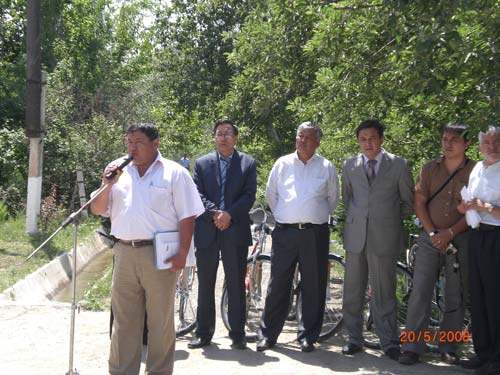
The national coordinator for SDC Water Programs said that the Canal Automation Project is being implemented since 2003 with the support of donors in our country and neighboring republics. Its aim is to create a necessary infrastructure, based on which rational, open and controlled water use will be ensured. Over this time, the partners provided almost US$ 2 million. A task has been set to automate the control system on three transboundary canals such as Aravan-Akbura, South Fergana (Uzbekistan) and Khodja-Bakirgan (Tajikistan).
Similar activities have already been completed at the first of the water structures. Automated gates, gauging equipment and data transmission devices were installed. The equipment enables now to control water inflow and outflow, water supply to any canal in required amount (precisely up to cubic meter). As a result, water use efficiency improves in 60 thousand hectares of lands in Osh province and adjacent areas in Uzbekistan.
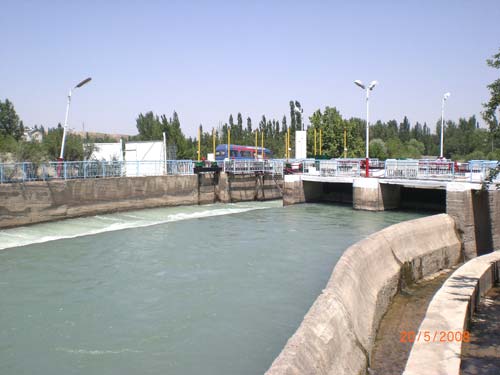
“Hundreds thousands of people will feel improvement. Water is a national wealth, and it should be saved,” governor Aaly Karashev stated in his speech. The need for a rational approach to water use issues is dictated by time. It is also dictated by the situation, i.e. water shortage observed this year. Specialists expect that water availability will now be 50-55% of the usual norm. Director of the Swiss Cooperation Office in Kyrgyzstan and Uzbekistan Hanspeter Maag also noted that in dry years like the current one, transparent and effective irrigation water management becomes even more important. And the implementation of such projects contributes to the prevention of water disputes among people of border communities.
“I am glad that we assist to solve these problems. And the objective to significantly improve the performance of irrigation systems is achieved at relatively low financial expenses,” he said.
As it turned out, altogether 235,000 dollars was spent for the automation of the Aravan-Akbura canal. At that, main hydro structures were repaired and personnel who would handle new equipment was trained. Director of the Scientific-Information Center ICWC Victor Dukhovny noted that Kyrgyzstan was always a leader in Central Asia in application of new methods for rational water use, and such initiative only helps to improve the situation.
“As a specialist with fifty-year work experience, I can say with confidence that water is not a source of conflicts, as sometimes some people say, but a base for our cooperation,” he stated. It has turned out that the canal automation project, at the Uchkurgan waterworks in Namangan province, has already been started in Uzbekistan under the umbrella of ICWC, and it has demonstrated good results. At that, emphasis was placed on integrated water resources management approach, which will act at the Aravan-Akbura canal as well.
Oybek Khamidov, “Vecherniy Bishkek”
|